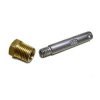Has anyone ever had a problem with only having two bolts to hold the starter???
For $27 more, I can get a starter with 3 holes (staggered mount) and it has the
same torque as their model 9500 does.
http://www.summitracing.com/parts/pwm-9526

Last edited:






